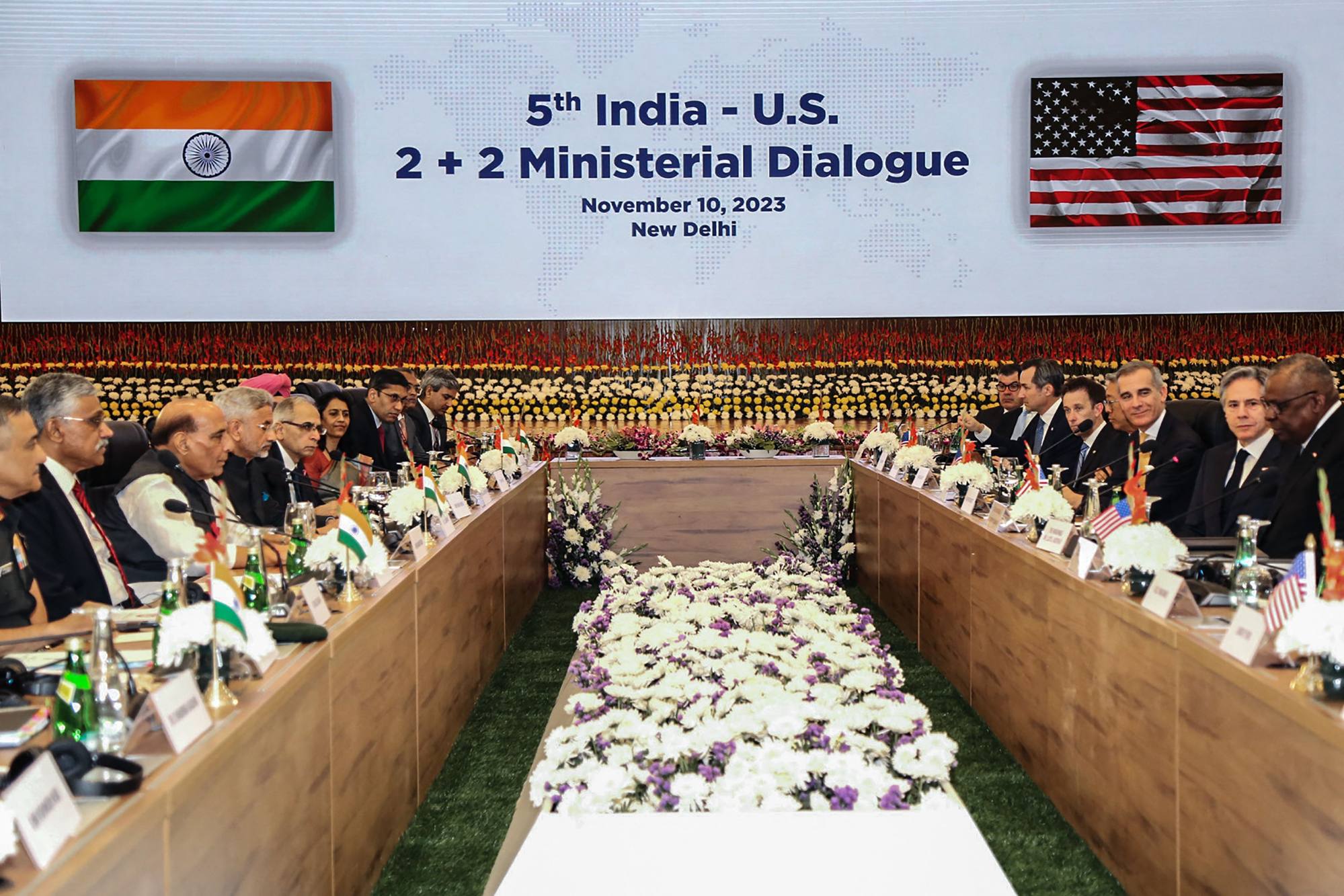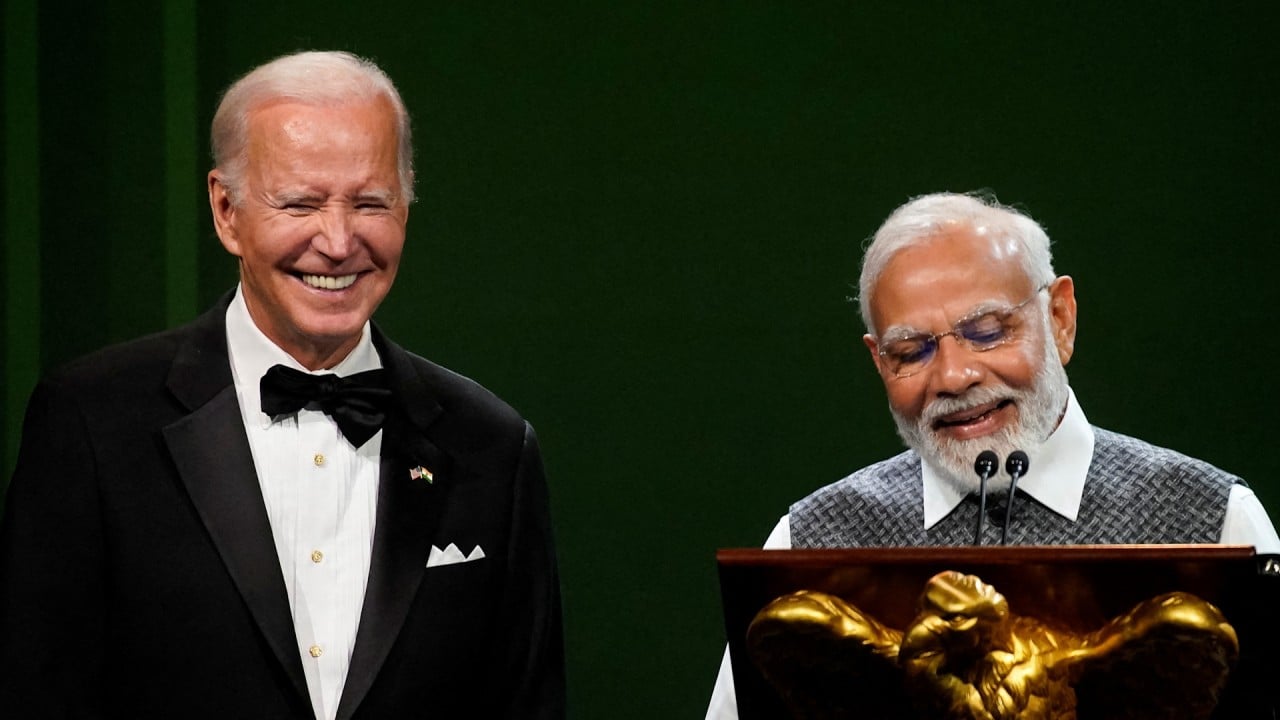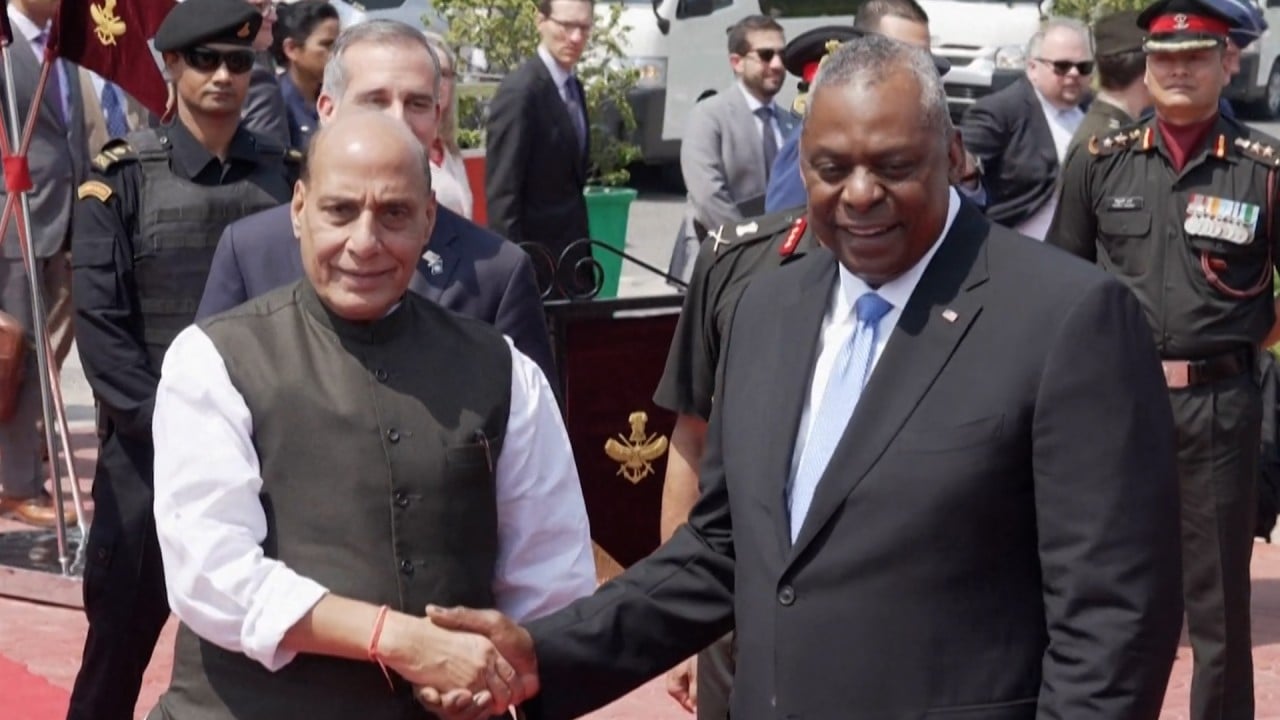
As Joe Biden deepens India ties to counter China, Donald Trump’s possible return looms over US ally
- At ‘2+2’ talks in New Delhi, the democratic allies pull closer as an agreement is reached for US and India to co-produce armoured combat vehicles
- If he returns to the White House, Trump has vowed to introduce an ‘automatic’ 10 per cent tax on all imports into the US
What began with a tight bear hug between defence chiefs of the United States and India on Thursday concluded with the further expansion of the two countries’ security partnership in the face of common rival China in the Indo-Pacific and beyond on Friday.
At the “2+2” US-India ministerial consultations, which brought together top diplomats and defence heads in New Delhi, the two sides agreed to discuss co-production of Stryker armoured vehicles amid tensions along India’s disputed Himalayan border with China. The move will also help India reduce its historic dependence on Russian weapons.
“An initial offer on the infantry combat vehicles has come from the US. We have expressed our interest in discussing it further to take the co-production part ahead,” senior Indian defence official Giridhar Aramane said on Friday.
The Stryker is a family of eight-wheeled armoured vehicles that can transport infantry and use different weapons, engineering and electronic systems.
“In the face of urgent global challenges, it’s more important than ever that the world’s two largest democracies exchange views, find common goals and deliver for our people,” US Defence Secretary Lloyd Austin said before Friday’s meeting, adding that the countries were integrating their “industrial bases, strengthening our interoperability and sharing cutting-edge technology”.
According to a joint statement on Friday, the ministers noted “their mutual interest to co-develop and co-produce ground mobility systems as they bring the two countries’ respective defence sectors closer together while enhancing Indian capabilities”.
In June, Biden hosted India’s Narendra Modi at the White House for a state visit and defended his description of Xi as a “dictator” during a press conference with his guest.
Modi’s moment: India’s PM gets big White House dinner on state visit
Though Biden did not take any question on Modi’s human rights record despite opposition to the visit within his own Democratic Party, the meeting resulted in deals spanning from semiconductors, critical minerals, defence and trade.
This included an agreement on allowing US-based General Electric to jointly produce F414 jet engines with India’s Hindustan Aeronautics. India also expressed interest in buying 31 MQ-9B drones worth US$3 billion.
On Friday, Austin said an update on the drones deal will be shared “at the right time” but confirmed that the countries would “co-produce an armoured vehicle”.
After regarding the US with suspicion for decades, India has felt compelled to align more closely with Washington and its allies as China’s military might and economic influence have grown.

India is also a member of the Quad, a US-led security bloc that includes Japan and Australia.
The group is aimed at what the Biden administration calls “maintaining peace and stability” in the Indo-Pacific region. But China has criticised it as a “small clique” that is “bent on provoking confrontation”.
India is the only Quad country that shares a land border with China.
On Friday, Secretary of State Antony Blinken said the US was “promoting a free and open, prosperous, secure and resilient Indo-Pacific, including by strengthening our partnership, through the Quad, with Japan and Australia”.
While the Indo-Pacific remained the focus of the discussion on Friday, the two sides also exchanged views on developments in West Asia, the Middle East and Ukraine.
Importance of US-India ties shown with Yellen’s latest trip amid China tensions
The joint statement said the ministers reiterated that the US and India “stand with Israel against terrorism” and “called for the immediate release of all remaining hostages”.
They also expressed support for humanitarian pauses and committed to continue close diplomatic coordination, including with key partners in the region, to prevent the conflict from spreading.
But as Biden draws Washington even closer to New Delhi, it is uncertain how long the comity will last.
Next November, the US will hold a presidential election, and a recent New York Times-Siena College poll shows Donald Trump, the twice-impeached former president, leading among registered voters in the battleground states of Arizona, Georgia, Michigan, Nevada and Pennsylvania.
Trump, who called himself a “tariffs man” for imposing additional 25 per cent duties on over US$300 billion in Chinese imports during his term in office, has promised to introduce an “automatic” 10 per cent tax on all imports into the US, including those from close ally India.
“The other thing I want to have is a matching tax,” Trump said in a Fox News interview in August, calling India “very big with the tariffs”.
He cited American motorcycle manufacturer Harley-Davidson as an example and exaggerated claims that India was levying tariffs of up to 200 per cent while the company’s Indian counterparts were getting away for “no tax, no tariff” in the US.
In fact, an Indian motorbike manufacturer would pay the “most favoured nation” rate of 2.4 per cent tax when exporting to the US.
India charges 50 per cent custom duty on two-wheelers imported in fully built form. Consumers pay around 30 per cent in local taxes when buying foreign bikes.
Trump boasted that he “came down very hard” on New Delhi’s demand to set up American factories in India to gain access its market.
Since taking office in January 2021, Biden has largely kept Trump’s tariffs on Chinese imports intact but has rushed to resolve outstanding trade disputes with India.
In June, US Trade Representative Katherine Tai announced that New Delhi had agreed to remove retaliatory tariffs – imposed in response to Trump’s duties on India’s steel and aluminium imports – on American products including chickpeas, lentils, almonds, walnuts and apples, among other items.
India is also a member of the Indo-Pacific Economic Framework, a US-led initiative to encourage 14 Indo-Pacific nations to pursue resilient and sustainable supply chains away from China.



